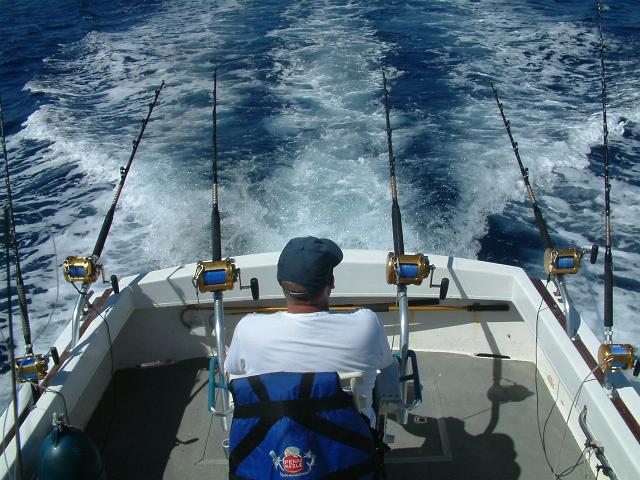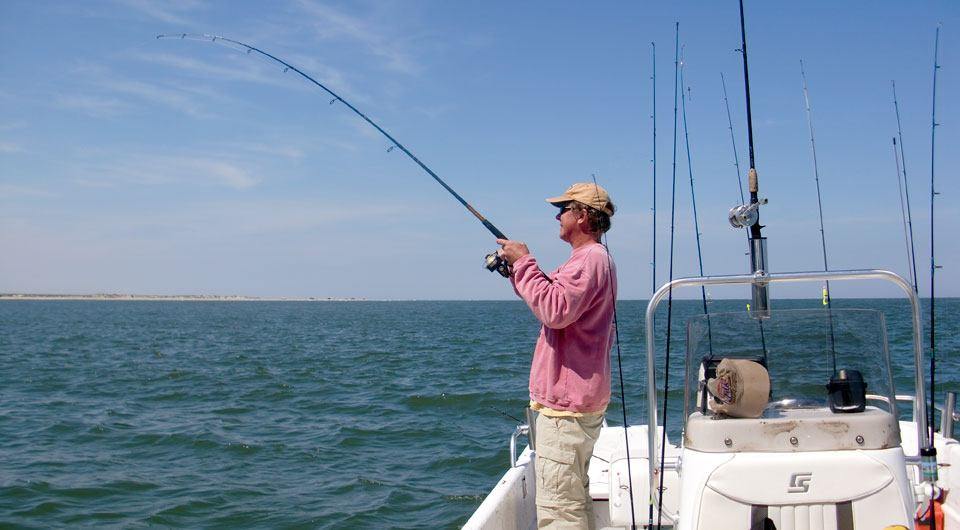Trolling, which entails pulling an artificial lure or mounted fish bait behind a motorboat at speeds of 1-10 knots, in either fresh or salt water, is in world-wide terms the most commonly practiced of all techniques.
Trolling is so effective because of the amount of water it covers, and the subsequent number of predators that get sight of the lure or mounted bait. Once you located fish by trolling, you can work the productive area systematically by casting while on the drift, or by anchoring up and offering baits all around the boat.
Or you can troll through the area time and again, trying a variety of different lures at varying depths to evaluate which works best and at what depth on the day.
More...
Trolling in Different Areas
Trolling might sound a rather boring and slow technique, but because you are constantly changing lures and exploring different depth-bands around varying features, and relating these to read-outs on the sonar screen, there is little time to become bored.
So much valuable information about each new water can be gathered for future trips, in addition to catching fish, although those that permit the boat to pass over them in depth water will show up, but more for the ever-changing bottom contours and the feature that attract predators.
Study areas around rock formations, for instance, with pinnacles, deep gullies, peaks and sudden drop offs, either well offshore or running parallel to the shoreline of islands. These are exactly the kinds of sub-surface features found, for instance, in the Irish and Scottish lochs around which shoal fish gather and predators subsequently patrol.

Via: http://www.biggamefishingtenerife.com
Aimlessly pulling lures through huge areas of featureless water is, by comparison, never likely to produce such immediate action as these veritable hot-sports.
Think of large, deep still waters (even wide rivers, estuaries and the sea itself) in cross-section, just like a huge layer cake, and then choose a suitable artificial lure. The technique is to allow the lure to be taken back behind the boat under gentle thumb pressure on the spool until it is 50-100ft away.
Then put the saltwater spinning reels into gear, and either hold the rod at a 45-degree angle, or put it into a rest. In depths from the surface, down to around 10 ft spinners, spoons, and shallow running plugs are the lures to use.
Trolling with Non-Diving Lures
Non-diving lures, such as big spoons, can be attractively presented by dropping them back every so often to flutter enticingly downwards with the reel in free spool. Then put the reel back into gear again instantly to make the spoon come alive as it suddenly zooms upwards to follow the boat.
Big brown trout and pike, especially, can be encouraged to grab hold using this simple ruse.
In depths to 10-20 ft, deep-diving plugs such as rapalas and russelures work best. The trolling paravane is an effective addition that allows virtually any lure, including many surface patterns, to work down at these depths.
Tie the reel line to the paravane’s angled head, and to the other end add a 6-8 ft monofilament trace with a link-swivel to facilitate quick changes of lure. As with standard trolling, if pike are expected a 12 in, 15 lb-test wire trace imperative.
When trolled at a standard 1 ½ - 2 ½ knots, the paravane quickly dives down, pulling the line behind it.
When trolling in wide estuary mouths for bass, the Toby-type lures, which were originally on the shape and action of the sand eel, are the best to try. These and other bar-type spoons work effectively, whether used in conjunction with a paravane or flat-line trolled.
Bass love rapala magnums, too, especially in blue mackerel.
The last depth band that can be effectively worked by standard or flat-line trolling (as opposed to downrigger trolling), 20-30 ft deep, is really only fishable with huge-lipped, deep-living plugs. Considerably more line must be let out behind the boat to enable these really deep divers to angle steeply down and do the business.
How to Start Trolling
Start with a slow trolling speed while the plug is diving down, and increase the throttle very slowly and steadily to around 1 ½ - 2 knots. An erratic trolling speed only encourages the plug to turn turtle and pop up to the surface.
It is best to secure the rod or rods (two anglers sharing a boat can work no more than two rods each) in adjustable, custom-made trolling rests. If there are no rests or rod-holders, each angler should only use one rod, holding it at all times while the boat is under power in case a fish grabs hold and takes it over the side.
Rods in the 9-11 ft category with a fast-tip, medium-to-heavy spinning action (Rods-freshwater) are perfect for trolling. Soft, all-through-actioned models cannot transmit sufficient power to the lure to make the hooks bite home on the strike.
The multiplier reel is the tool for trolling, and the drag should be set firmly for the hooks to bite home on the strike, yet not so tight that line cannot be taken by a big fish. Leave the reel’s ratchet on to provide an audible alarm, but quickly flip it off once a fish is hooked.

Via: http://soundsideadventures.com/
Trolling puts enormous demands on tackle because hits come so suddenly when fish lunge at the moving lure, so an increase in line strength of 25-30 percent on what you would normally use to cast the same lure provides a safeguard against break-offs.
Most spinners, plugs and spoons used to catch pike, big brown trout and even salmon can be trolled comfortably on a 15lb-test reel line, the only exception being when huge-lipped diving plugs or heavy spoons are in use, as they put enormous pressure on the line, and when downright trolling.
In both cases line strength should then be increased to 18-10 lb test, especially if a sizeable salmon is on the cards.
Final Thoughts
Remember that sudden acceleration or deceleration is always a worthwhile ploy to make predators grab a lure or bait when working over known features without success, whether you are downrigger or flat-line trolling.
We hope this post was useful to you. Here’s a quick video about trolling that shows just how fun this fishing technique is:
Leave a Reply